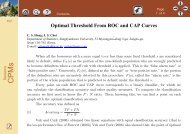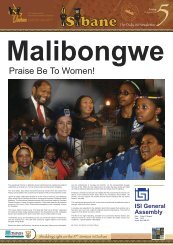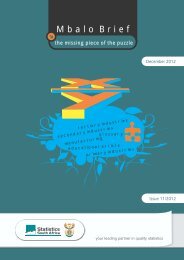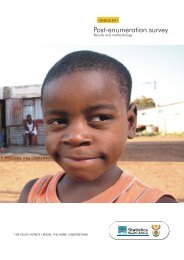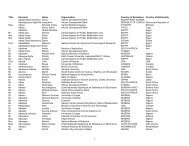General household survey - Statistics South Africa
General household survey - Statistics South Africa
General household survey - Statistics South Africa
Create successful ePaper yourself
Turn your PDF publications into a flip-book with our unique Google optimized e-Paper software.
<strong>Statistics</strong> <strong>South</strong> <strong>Africa</strong> 34<br />
P0318<br />
The proper disposal of <strong>household</strong> waste and refuse is also important to maintain environmental hygiene.<br />
Figure 31 shows that the percentage of refuse removal services provided by municipalities throughout the<br />
country was notably higher in the largely urbanised provinces of Gauteng (87,9%) and Western Cape<br />
(88,1%) in 2011 compared to lower levels in more rural Eastern Cape (44,0%), Mpumalanga (38,5%) and<br />
Limpopo (16,1%). Nationally, the percentage of <strong>household</strong>s whose refuse was removed by the municipality<br />
increased from 57,8% to 61,0% between 2002 and 2011. In 2011, 55,7% (down from 61,4% in 2010) of<br />
<strong>South</strong> <strong>Africa</strong>n <strong>household</strong>s were paying for the removal of their refuse. In addition to the 57,8% of<br />
<strong>household</strong>s for whom refuse was removed on a weekly basis by the municipality, the municipality less<br />
frequently removed refuse for a further 1,9% of <strong>household</strong>s.<br />
Figure 31: Percentage of <strong>household</strong>s whose refuse is removed by the municipality at least once a<br />
week by province, 2002, 2003, 2007 and 2011<br />
12. Telecommunications<br />
Figure 32 summarises statistics collected on access to functional landlines and cellular phones within the<br />
sampled dwelling units in 2011. Nationally, less than ten per cent (9,1%) of <strong>household</strong>s did not have<br />
access to either landlines or cellphones. Households without access to these communication media were<br />
most common in Northern Cape (19,3%), Eastern Cape (16,0%) and also Free State and North West (both<br />
11,3%). Merely 0,8% of <strong>South</strong> <strong>Africa</strong>n <strong>household</strong>s used only landlines.<br />
By comparison, three-quarters of <strong>South</strong> <strong>Africa</strong>n <strong>household</strong>s (75,5%) used only cellular phones in the<br />
dwelling. The largest percentages were observed in Limpopo (88,3%), Mpumalanga (87,1%), North West<br />
(81,8 %) and Free State (78,9%). Western Cape had the lowest percentage of <strong>household</strong>s who had only<br />
cellular phones in their dwellings (54,3%) and the highest percentage of <strong>household</strong>s that were using only<br />
landlines (2,9%). The use of a combination of both cellular phones and landlines in <strong>household</strong>s was most<br />
prevalent in the more affluent provinces, namely Western Cape (32,3%) and Gauteng (19,6%).<br />
<strong>General</strong> Household Survey, July 2011



